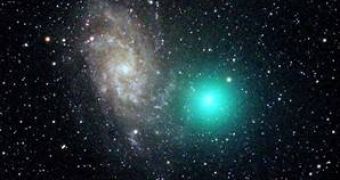Being the eighth comet ever recognized as to be periodical, the comet Tuttle should be visible in the next two weeks without the aid of optical instruments. Having an orbital period of 13.7 years, the comet 8P/Tuttle is one of the brightest of the short-period comets. Furthermore, while watching after Tuttle, you should also check for the famous comet Holmes, which, in late October last year, suffered a powerful outburst that determined an increase in brightness of over one million times. Several weeks later, it was officially catalogued as the largest object in the solar system after the debris field ejected from the main body reached a volume larger than the Sun's.
The first comet to be classified as a periodical comet was comet Halley, in 1705, by Edmund Halley, although the comet had been spotted in multiple occasions before. The same is true for the comet Encke, the second periodical comet discovered which was classified back in 1786 but had been observed in at least three other returns before Johan Franz Encke's detection. Though catalogued, the object was again classified by comet hunter Pierre M?chain, during its fifth recorded return in 1790, under the name of 'Comet 1790 II', after which the comet eluded observation for more than seven decades.
The first positive discovery of a comet by Horace P. Tuttle was made during the early 1858, and the discoverer observed another two in the same year. With a magnitude of 7, comet 8P/Tuttle was best observed in the month of February due to an optimal position relative to the Earth, which enabled detailed measurements to be made. The astronomer himself proposed that the object he observed had been previously classified as 1790 II. During the four previous returns of the comet before the discovery, it was rendered invisible in three occasions due to orbital trajectories which took it close to the Sun, while during the fourth it was missed by chance.
Its orbit around the Sun takes it just outside the Earth's orbit, as on the first day of this year the comet approached the Earth at only 38 million kilometers, and is currently following a trajectory that will take it in the near vicinity of the Sun. In fact this is why comets are so visible in the first place. As they approach the Sun, the rise in temperature determines the emission of volatile gases which diffuse the light. Calculations of its path reveal that the comet will cross the region of sky in which the Pisces constellation is located, towards the Cetus constellation.
After exiting the Cetus constellation, 8P/Tuttle will enter Fornax, and will become unavailable to observation for the people living in the northern hemisphere. February will render the comet invisible as it falls towards the outer regions of the solar system.
Returning to the Holmes comet now, scientists still have no clue what event might have triggered the outburst during the late October. Some suggested that the main body of the Holmes comet, the coma, has a rather fragile structure which collapsed on itself and ejected large amounts of dust in the process. The comet is not at its first display of this kind, showing two separate outbursts right in the year when it was discovered, nearly 75 years ago.
Astronomers believe that, in order to reach a stability point, the main body of the comet should suffer a second collapse, just as it did back in 1892, but almost three months passed since then and nothing happened.

 14 DAY TRIAL //
14 DAY TRIAL //